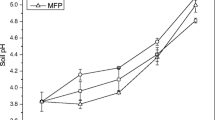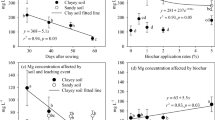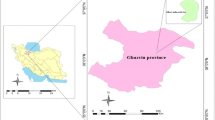Abstract
Goal, Scope and Background
Transport of P from agricultural land contributes to the eutrophication of surface waters. Soil amendment is considered one of the best management practices (BMPs) to reduce P loss from sandy soils. Laboratory column leaching experiments were conducted to evaluate the effectiveness of different soil amendments in reducing P leaching from a typical sandy soil in Florida.
Methods
The tested amendments were CaCl2, CaCO3, Al(OH)3, cellulose, and mill mud, and applied at the rate of 15 g/kg for a single amendment and each 7.5 g/kg if two amendments were combined. Leaching was conducted every four days for 32 days, 250 mL of deionized water being leached for each column per leaching event. Leachates were collected from each leaching event and analyzed for reactive P, PO4-P, and macro and micro-elements.
Results and Discussion
Except for the soils amended with CaCl2, or CaCl2+CaCO3, reactive P and PO4-P leaching losses mainly occurred in the first three leaching events. Phosphorus leaching from the soils amended with CaCl2 or CaCl2+CaCO3 was less but more persistent than that of other amendments. Reactive Pleaching loss was reduced by 36.0% and 40.4% for the amendments of CaCl2, and CaCl2+CaCO3, respectively, as compared with chemical fertilizer alone, and the corresponding values for PO4-P were 70.8% and 71.9%. The concentrations of K, Mg, Cu, and Fe in leachate were also decreased by CaCl2 or CaCl2+CaCO3 amendment. Among the seven amendments, CaCl2, CaCO3, or their combination were most effective in reducing P leaching from the sandy soil, followed by cellulose and Al(OH)3, the effects of mill mud and mill mud + Al(OH)3 were marginal.
Conclusions
These results indicate that the use of CaCl2, CaCO3, or their combination can significantly reduce P leaching from sandy soil, and should be considered in the development of BMPs for the sandy soil regions.
Recommendations and Outlook
Most agricultural soils in south Florida are very sandy with minimal holding capacities for moisture and nutrients. Repeated application of fertilizer is necessary to sustain desired yield of crops on these soils. However, eutrophication of fresh water systems in this area has been increasingly concerned by the public. Losses of P from agricultural fields by means of leaching and surface runoff are suspected as one of the important non-point contamination sources. The benefits and effectiveness of soil amendment in reducing P losses from cropping production systems while sustaining desired crop yield need to be demonstrated. Calcium chloride, CaCO3, or their combination significantly reduce Pleaching from sandy soil, and should be considered in the development of BMPs for the sandy soil regions.
Similar content being viewed by others
References
Chamberlain R, Hayward D (1996): Evaluation of water quality and monitoring in the St. Lucie Estuary. J Am Water Res Assoc 32, 681–696
Chen GC, He ZL, Stoffella PJ, Yang XE, Yu S, Calvert D (2006): Use of dolomite phosphate rock (DPR) fertilizers to reduce phosphorus leaching from sandy soil. Environ Pollut 139, 176–182
Daniel TC, Sharpley AN, Lemunyon JL (1998): Agricultural phosphorus and eutrophication: A symposium overview. J Environ Qual 27, 251–257
Eghball B, Binford GD, Baltensperger DD (1996): Phosphorus movement and adsorption in a soil receiving long-term manure and fertilizer application. J Environ Qual 25, 1339–1343
Elliott HA, O’Connor GA, Brinton S (2002): Phosphorus leaching from Biosolids-amended sandy soils. J Environ Qual 31, 681–689
He ZL. Yuan KN, Zhu ZX (1992): Effect of ionic strength and cation on phosphate desorption. Acta Pedologica Sinica 29, 26–33
He ZL, Calvert DV, Alva AK, Li YC (2000): Management of nutrients in citrus production systems in Florida: An overview. Soil Crop Sci Soc Florida Proc 59, 2–10
Hoogeweg CG, Hornsby AG (1997): Simulated effects of irrigation practices on leaching of citrus herbicides in Flatwoods and Ridge-type soils. Soil Crop Sci Soc Fla Proc 56, 98–108
Kuo K (1996): Phosphorus. In: Sparks DL (ed), Methods of soil analysis, part 3: Chemical methods. Published by Soil Science Society of America, Inc. Madison, Wisconsin, USA, pp 869–919
O’Connor GA, Brinton S, Silveira ML (2005): Evaluation and selection of soil amendments for field testing to reduce P losses. Soil Crop Sci Soc Florida Proc 64, 22–34
Parry R (1998): Agricultural phosphorus and water quality: A U.S. Environmental Protection Agency perspective. J Environ Qual 27, 258–261
Smith VH (2003): Eutrophication of freshwater and coastal marine ecosystems — A global problem. Env Sci Pollut Res 10(2) 126–139
Tucker DPH, Alva AK, Jackson LK, Wheaton TA (1995): Nutrition of Florida citrus trees. Univ of Fla Coop Ext Ser SP-169, Gainesville
Extended Literature
Biselli S, Reineke N, Heinzel N, Kammann U, Franke S, Huhnerfuss H, Theobald N (2005): Bioassay-directed fractionation of organic extracts of marine surface sediments from the North and Baltic Sea — Part I: Determination and identification of organic pollutants. J Soils Sediments 5(3) 171–181
Blumfield TJ, Xu ZH, Prasolova NV, Mathers NJ (2006): Effect of overlying windrowed harvest residues on soil carbon and nitrogen in hoop pine plantations of subtropical Australia. J Soils Sediments 6(4) 243–248
Domokos E, Holenda B, Utasi A, Redey A, Fazakas J (2005): Effect of long retention time in the settler on phosphorus removal from communal wastewater. Env Sci Pollut Res 12(5) 306–309
Foerstner U, Westrich B (2005): BMBF coordinate research project SEDYMO (2002–2006) — Sediment dynamics and pollutant mobility in river basins. J Soils Sediments 5(3) 134–138
Khan S, Cao Q, Chen BD, Zhu YG. (2006): Humic acids increase the phyto availability of Cd and Pb to wheat plants cultivated in freshly spiked, contaminated soil. J Soils Sediments 6(4) 236–242
Ladakis M, Dassenakis M, Pantazidou A (2006): Nitrogen and phosphorus in coastal sediments covered by cyanobacteria mats. J Soils Sediments 6(1) 46–54
Rosolen V, Herpin U, Fraenzle S, Breulmann G, de Camargo PB, Paganini WS, Cerri CC, Melfi AJ, Markert BA (2005): Land application of wastewater in Brazil — A scientific challenge: Chemical characterization of soil at Populina, Sao Paulo State. J Soils Sediments 5(2) 112–120
Schuwirth N, Hofmann T (2006): Comparability of and alternatives to leaching tests for the assessment of the emission of inorganic soil contamination. J Soils Sediments 6(2) 102–112
Sigua GC, Adjei MB (2005): Cumulative and residual effects of repeated sewage sludge applications: Forage productivity and soil quality implications in South Florida, USA. Env Sci Pollut Res 12(2) 80–88
Sigua GC, Coleman SW (2006): Sustainable management of nutrients in forage-based pasture soils: Effect of animal congregation sites. J Soils Sediments 6(4) 249–253
Sigua GC, Griffin J, Kang W-J, Coleman SW (2004): Wetland conversion to beef cattle pasture: Changes in soil properties. J Soils Sediments 4(1) 4–10
Sigua GC, Holtkamp ML, Coleman SW (2004): Assessing the efficacy of dredged materials from lake Panasoffkee, Florida: Implication to environment and agriculture — Part 2: Pasture establishment and forage productivity. Env Sci Pollut Res 11(6) 394–399
Author information
Authors and Affiliations
Corresponding author
Rights and permissions
About this article
Cite this article
Yang, J., He, Z., Yang, Y. et al. Use of amendments to reduce leaching loss of phosphorus and other nutrients from a sandy soil in Florida. Env Sci Poll Res Int 14, 266–269 (2007). https://doi.org/10.1065/espr2007.01.378
Received:
Accepted:
Published:
Issue Date:
DOI: https://doi.org/10.1065/espr2007.01.378




